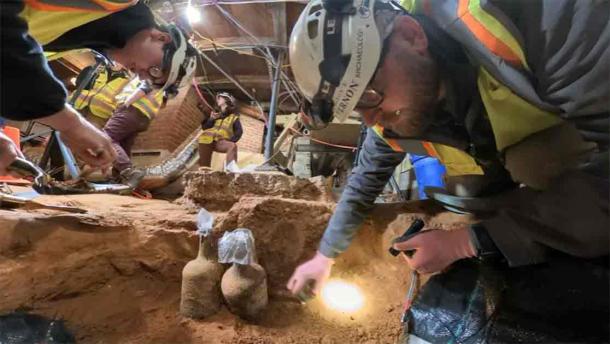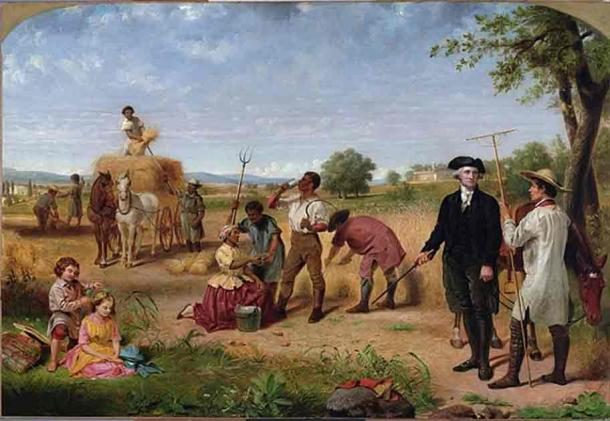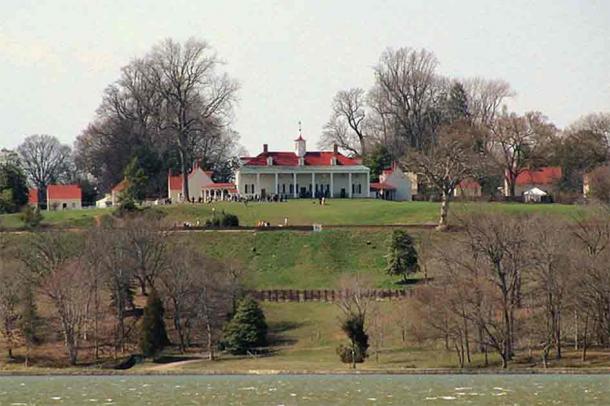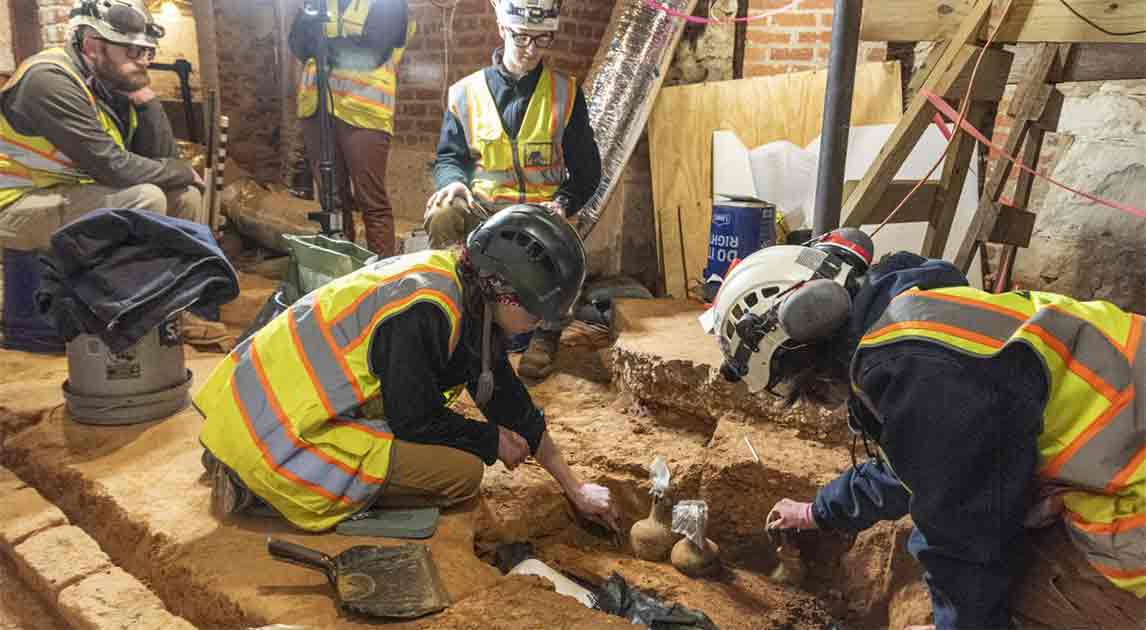George Washington’s Refurbished Manor Has Sealed Bottles from 18th Century
As part of the $40 million Mansion Revitalization Project, archaeologists have unearthed two sealed, 18th-century European glass bottles at George Washington’s Mount Vernon mansion. Analysis has revealed a distinctive scent held within the bottles.
- Solomon's Builders: Freemasons, Founding Fathers And The Secrets Of Washington D.C.
- American People Suffering Historical Amnesia With Many Citizens Knowing “Virtually Nothing” About Their History
European Style Bottles From the 18th Century: Typically Characterized
Mount Vernon, once the residence and plantation of George Washington, a Founding Father, and the first president of the United States, is undergoing restoration efforts to preserve its historic significance. The historic home of the first president is situated 8 miles (12.8 km) down the Potomac River from the nation’s capital.
These bottles were found upright and sealed, each containing liquid. The bottle shapes are characteristic of styles from the 1740s - 1750s and were recovered from a pit where they may have been forgotten and eventually buried beneath a brick floor laid in the 1770s, according to information shared with Inside the Beltway, reports Washington Times. These dark green glass bottles were discovered buried in a pit beneath the cellar’s brick flooring from the 1770s.
- The Story Of Eliza Hamilton: The Woman Behind A Great Man
- Revolutionary Era Log House Found Hidden in US Building

Two well-preserved European bottles found within the basement of this historic residence. (Mount Vernon Ladies' Association)
Following their discovery, the bottles underwent conservation efforts, while their liquid contents were transported to a laboratory for scientific analysis under controlled conditions. The analysis disclosed that the liquid within the bottles retained the characteristic scent of cherry blossoms, reminiscent of the spring season in the region. The contents included preserved cherries, complete with stems and pits.
In efforts to safeguard the approximately 250-year-old glass bottles, researchers took the precautionary step of transferring their contents—comprising cherries, pits, stems, and a "gooey residue"—into smaller vessels for forthcoming analysis, as reported by The Washington Post.
Cherry Blossoms and Slave Plantations
"There are whole, recognizable cherries," Jason Boroughs, Mount Vernon's principal archaeologist, told TWP. "It actually smelled like cherry blossoms when we got to the bottom."
Researchers hypothesize that the predominant, amber-colored liquid may predominantly consist of groundwater that infiltrated the bottles as their cork seals deteriorated over time. They also speculate that the cherries were likely harvested at Mount Vernon during the 1770s, potentially preceding the Revolutionary War, and were intentionally preserved for future consumption.
During colonial times, a favored beverage known as cherry bounce gained popularity. This concoction, enjoyed by both George and Martha Washington, was crafted from brandy, spices, sugar, and cherry juice. However, cherry bounce was typically stored in larger vessels. In light of this, archaeologists deduced that the recently unearthed cherries were likely intended for alternative purposes, such as culinary endeavors like cooking or baking, rather than for the production of cherry bounce.
"There are 18th century accounts that talk about proper ways of preserving fruits and vegetables," Boroughs said. "One of the most common, especially for berries, is to dry them as much as possible … put them in a dry bottle, cork it … and then bury them."
The cherries found at Mount Vernon were not harvested by George Washington himself, but rather by some of the hundreds of enslaved individuals residing at the estate during that period. The well-known anecdote of a young Washington damaging a cherry tree with a hatchet and subsequently confessing, famously stating, "I cannot tell a lie," has been revealed as a myth concocted by a biographer.

Washington as Farmer at Mount Vernon", 1851, part of a series on George Washington by Junius Brutus Stearns. Located at the Virginia Museum of Fine Arts (Public Domain)
Mount Vernon: A Historical Milestone
Mount Vernon, situated in Fairfax County, Virginia, holds a distinguished place in American history as the cherished estate of George Washington, the nation's first President. Its origins trace back to the 17th century when the land was initially acquired by John Washington, George's great-grandfather. Upon the passing of his older half-brother Lawrence in 1754, George Washington inherited the estate, marking the beginning of his association with Mount Vernon.
Over time, Washington undertook extensive expansion and development efforts, enlarging the estate from its original 2,000 acres to over 8,000 acres through strategic land acquisitions. The iconic mansion at Mount Vernon stands as a testament to Washington's architectural vision, showcasing classic Georgian design with a two-story central block flanked by one-story wings.
Throughout Washington's ownership, the estate served as a thriving plantation, primarily cultivating tobacco during its early years. However, Washington also implemented innovative agricultural practices and diversified the estate's crops, reflecting his commitment to agricultural experimentation and sustainability. Today, Mount Vernon stands as a cherished national landmark, offering visitors a glimpse into the life and legacy of one of America's most revered Founding Fathers.
From 2023 to 2026, the Mansion Revitalization Project is overseeing a comprehensive preservation endeavor aimed at safeguarding the original building fabric of the Mansion and ensuring its structural integrity. This discovery comes at the beginning of an exciting and transformational project to strengthen and restore the home of the nation’s first president so that it will be stronger than ever when they celebrate America’s 250th birthday in 2026
Construction of the present manor commenced in 1734 under the direction of George Washington’s father, Augustine Washington. The manor was built gradually over time, with the architect remaining unidentified.

Mount Vernon seen from the Potomac River. (baldeaglebluff from Bald Eagle Bluff/USA, CC BY-SA 2.0)
Designated as a National Historic Landmark in 1960 and listed on the National Register of Historic Places, Mount Vernon is currently owned and maintained by the Mount Vernon Ladies’ Association—the oldest national historic preservation organization in the United States.
Top image: As part of the groundbreaking $40 million Mansion Revitalization Project funded by private donors, archaeologists unearth two intact, sealed 18th-century glass bottles at George Washington's Mount Vernon estate. Source: Mount Vernon Ladies' Association
By Sahir Pandey
References
Harper, J. 2024. New finding of old bottles at Mount Vernon a cherry surprise for all. Available at: https://www.washingtontimes.com/news/2024/apr/22/inside-beltway-new-finding-old-bottles-mount-verno/.
Milligan, M. 2024. Sealed 18th century glass bottles discovered at George Washington’s Mount Vernon. Available at: https://www.heritagedaily.com/2024/04/sealed-18th-century-glass-bottles-discovered-at-george-washingtons-mount-vernon/151740.
Nalewicki, J. 2024. George Washington's stash of centuries-old cherries found hidden under Mount Vernon floor. Available at: https://www.livescience.com/archaeology/george-washingtons-stash-of-centuries-old-cherries-found-hidden-under-mount-vernon-floor.
Ruane, M.E. 2024. Centuries-old bottles of cherries unearthed at George Washington’s home. Available at: https://www.washingtonpost.com/history/2024/04/22/cherries-george-washington-mount-vernon-1770/.
















